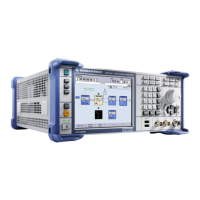Instrument Function
R&S
®
SMBV100A
408Operating Manual 1176.8016.02 ─ 17
Figure 5-25: ARB Multi Segment Waveform Concept
It is also possible to create and output a blank segment, i.e. segments containing a
zero signal.
Typical applications for the multi segment mode are described in section "Typical
Applications for Multi Segment Waveforms" on page 422.
Multi Segment Waveforms Processing
Processing of the waveform is triggered by the "Create" or "Create and Load" function.
To process the waveform, the instrument loads the entire multi segment waveform into
the memory. It is therefore possible to alternate between the individual waveforms
without delay due to loading. You can define the output order of the segments, as well
as the segment intended to be output at any given moment.
When the created waveform is loaded, the graphical interface displays information on
clock rate, number of samples and creation day. Additionally, you can acquire informa-
tion about the waveform in the dedicated "Waveform Info" dialog.
The ARB Sequencer Mode
If very high switch over speeds are required, the test signals can be continuously scrol-
led through with the aid of an external trigger or by applying a predefined “Play List”.
The R&S SMBV provides the possibility not only to define a sequence of different seg-
ment but also to determine whether a segment is played once or repeated several
times and to adjust the transition between the segments.
For the correct and fast processing as well as for seamless transition between the mul-
tiple waveforms, segments with a common sample rate are required. If the combined
waveforms features different sample rates, they should be adapted to a common sam-
ple rate by resampling. Another advantage of this procedure is the scaling of the
instantaneous amplitude of the various waveforms to a common RMS level.
Baseband Signal - Baseband Block

